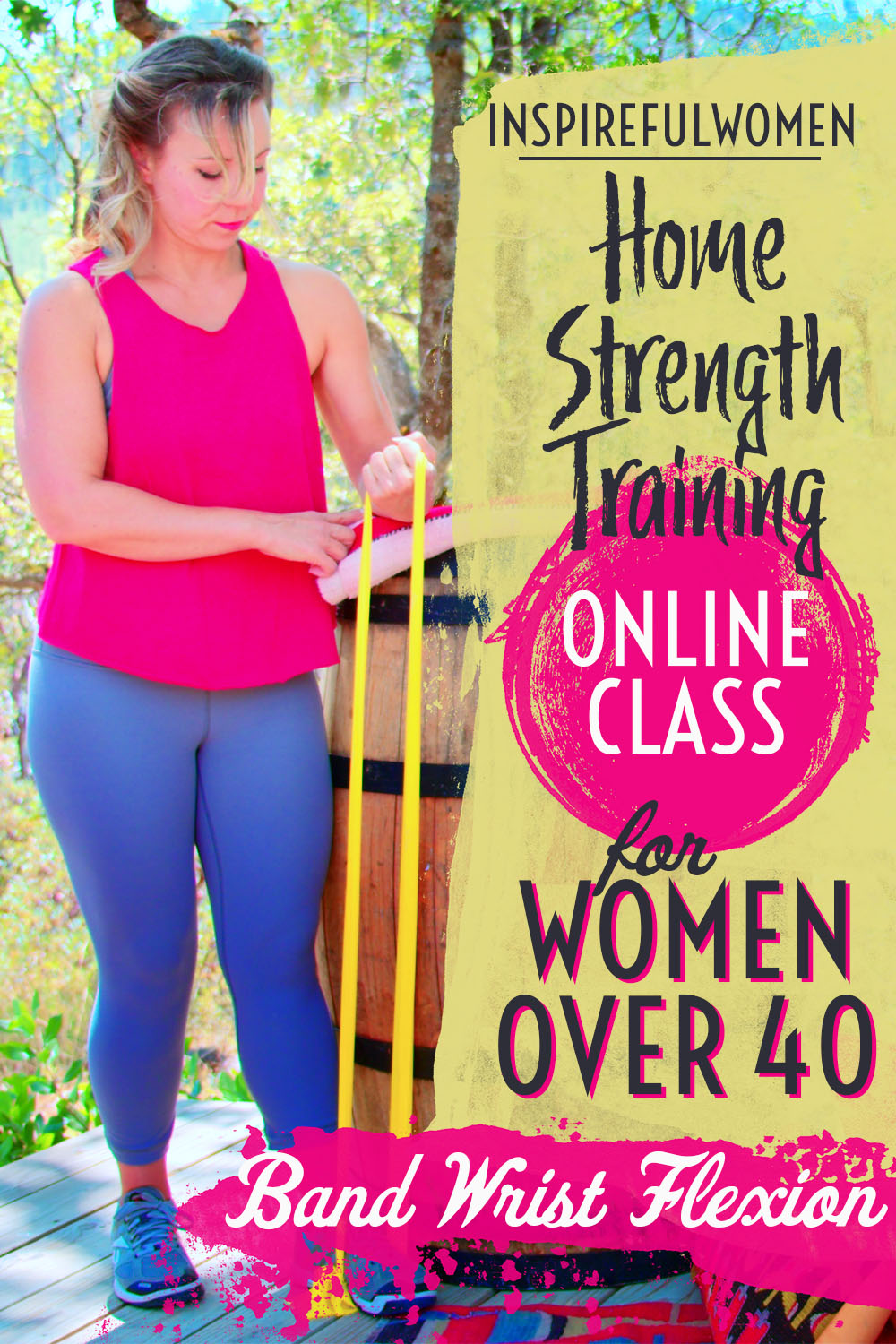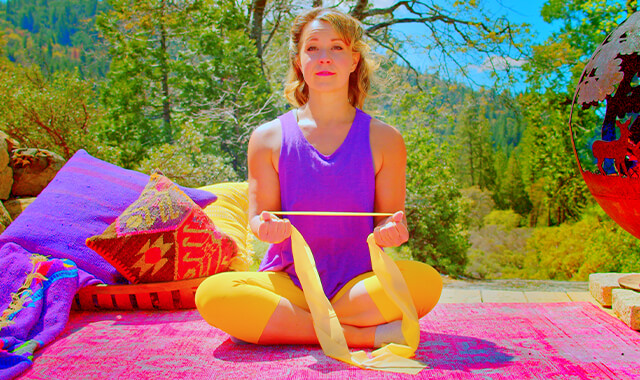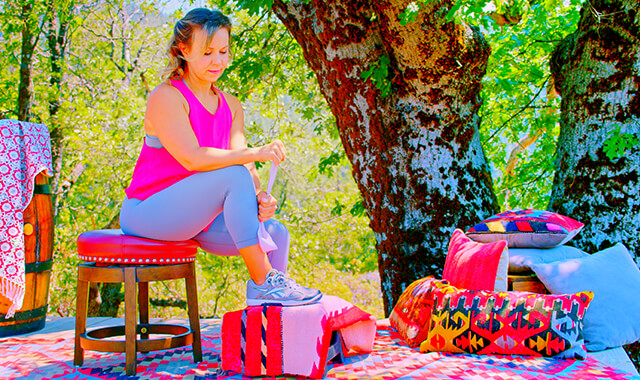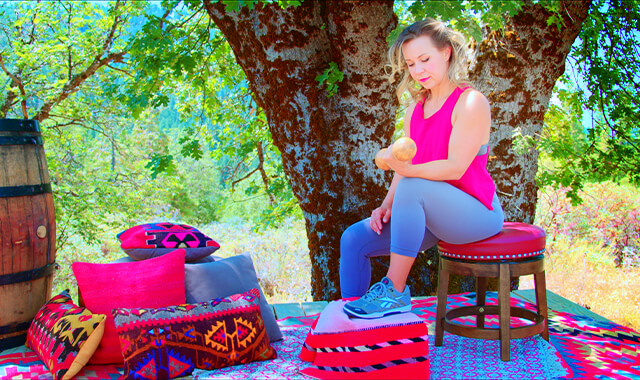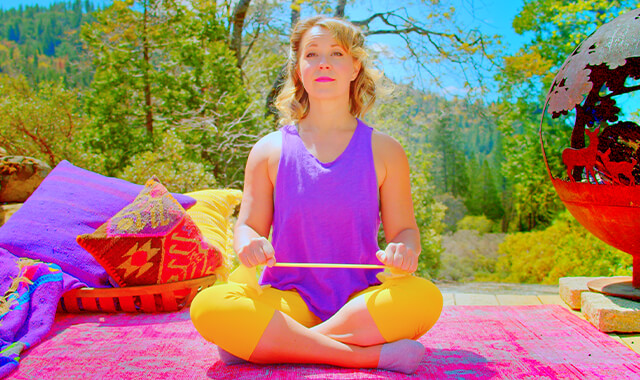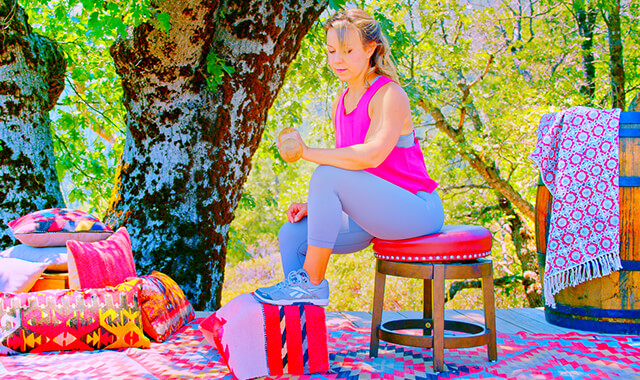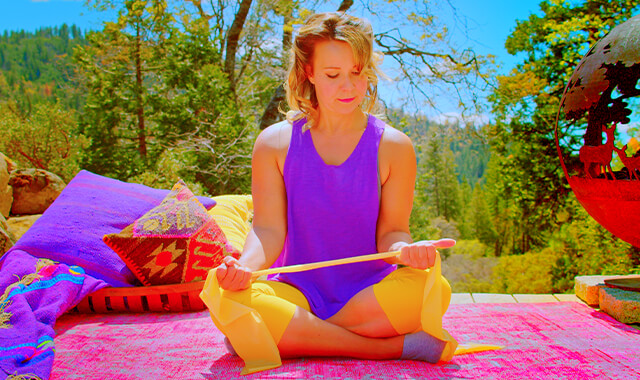Band Wrist Flexion
How to Do Band Wrist Flexions - Muscle Building Forearm Exercise | In-Depth Guide [VISUAL LEARNERS] Beginner
Proper Form, Common Mistakes, & Variations | Home Resistance Training
WHAT DO YOU WANT TO SEE?
QUICK DEMO
QUICK DEMO
MUSCLES THIS WORKS
MUSCLES
MAIN MUSCLES WORKED IN The Band Wrist Flexion
MANY WRIST MUSCLES - SEE BELOW
Flexor carpi radialis, flexor carpi ulnaris, extensor carpi radialis longus and brevis, extensor carpi ulnaris and palmaris longus.
OTHER MUSCLES WORKED:
- Flexor digitorum profundus and superficialis
- Palmar interossei
- Flexor digiti minimi brevis
STARTING POINTERS
Starting Pointers
WHAT WE'RE DOING TODAY
ALL WE'RE DOING:
Bending your wrist back and forth, like knocking on a door...except the door is laying on your lap.
This version of the wrist flexion exercise uses a band for resistance and you can easily perform this exercise in the comfort of your own home. The “non-working” hand or foot can be used to anchor the band. Wrist-strengthening exercises are essential for building resilience and stability in your wrists.
The exercise works the muscles that move the palm of the hand closer to the forearm. The muscles attach just above the elbow joint on the inside of the upper arm. The forearm is supported to prevent the biceps from trying to help out.
HOW TO DO THE EXERCISE
LOOKS
HOW Band Wrist Flexions SHAPE OUR BODY
Toned forearms - you may be surprised by the muscles on the inside of the forearm that will take shape! If you are strengthening your upper arms - the forearm work will balance that look.
PROPER FORM
PROPER FORM: Band Wrist Flexions
EQUIPMENT, SETS & REPS
EQUIPMENT
Main set (3: Light/Med/Heavy)
X-Heavy Band (I recommend getting this too if you plan to use resistance bands frequently).
Looped band if possible.
Chair and surface that allows you to support the forearm but have the hand suspended over the edge: the corner of a table or hinged forward with your forearm supported on your thigh.
SUGGESTED STARTING WEIGHT FOR WOMEN:
Light
SETS & REPS:
1 - 2 sets of 8 - 10 (if you have a history of elbow or wrist pain, start with one set of 8)
PACE:
Moderate up (concentric) and slow down (eccentric) - controlled
BODY POSITION
BODY POSITION FOR THE Band Wrist Flexion
BODY STANCE: Sit with a neutral spine, if you are using your thigh to support your forearm then hinge forward at your hips; sternum lifted shoulders back.
BAND: Anchor the band:
- With your “non-working” hand: hold one end of the loop (you will have to shorten up on it) and loop the other end across the palm of your working hand. Hold the anchoring hand a few inches right under your working hand. Position your anchoring hand so that the pull of the band is straight down - not pulling more to either side. It is most comfortable if you stabilize your anchoring arm on your thigh (if hinged forward) or close to your torso.
- With the foot: use a looped band and secure one end under your foot (same side as your working hand) and the other end across the palm of your working hand.
ARMS: Upper arm relaxed (it may be neutral or slightly flexed depending on your set up - but it should be relaxed and not involved). Elbow bent - depending on the set up this may be more or less bent, having your forearm approximately parallel to the floor is good. Forearm: supported on surface, palm up (supinated), holding the band. Your hand is not supported, but free to move up and down. Wrist bent back so that your hand is hanging down towards the floor.
HOW TO DO
HOW TO DO Band Wrist Flexions
CUE: Try to move very smoothly and will control - jerky movements mean the muscle is weak.
Bend your wrist to lift your palm towards your forearm.
At the end of the movement, slowly lower your hand down.
Repeat for the desired number of reps.
HOW TO SAFELY GET OUT OF THE EXERCISE
From the starting position, release the band from the anchor.
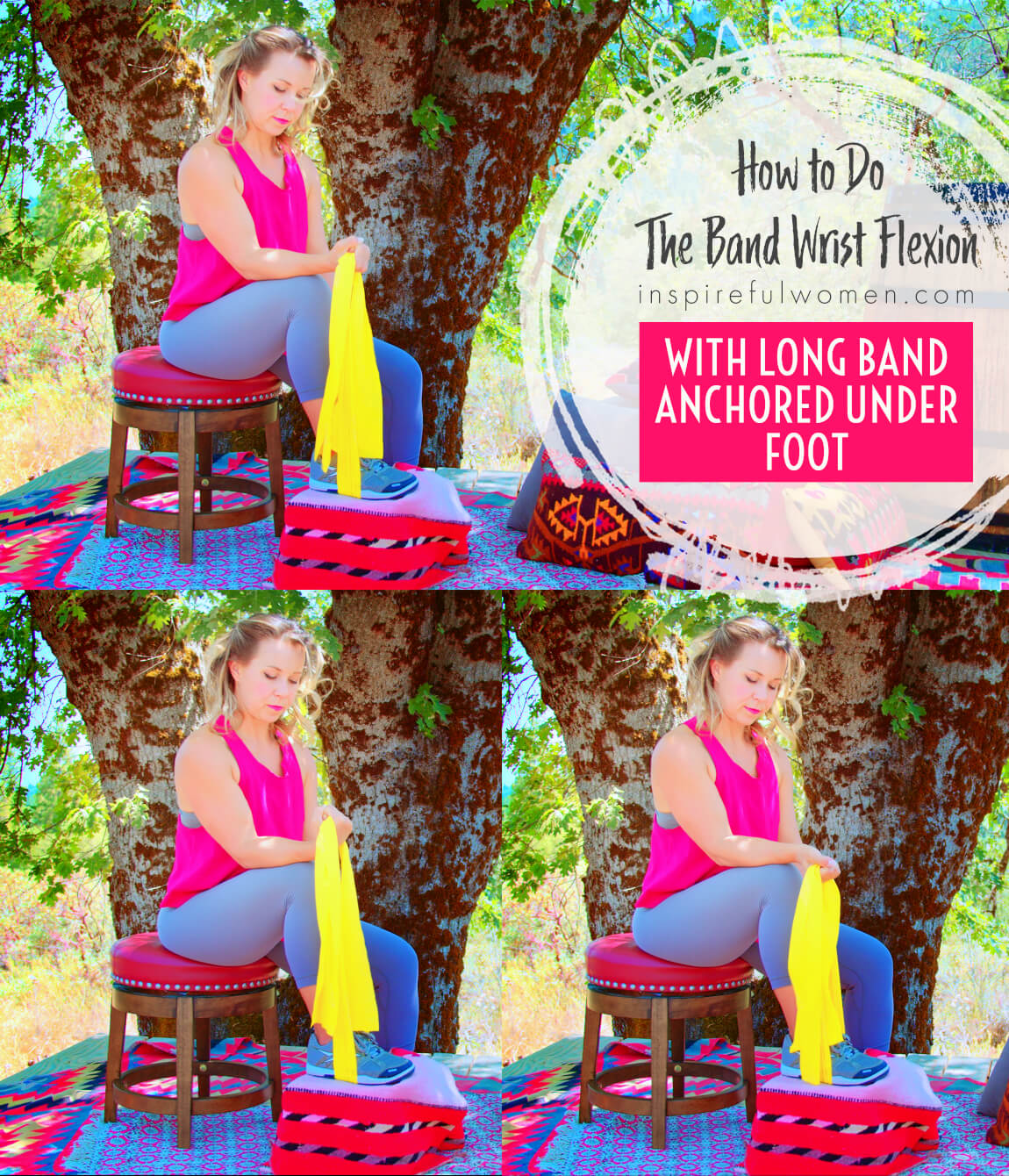
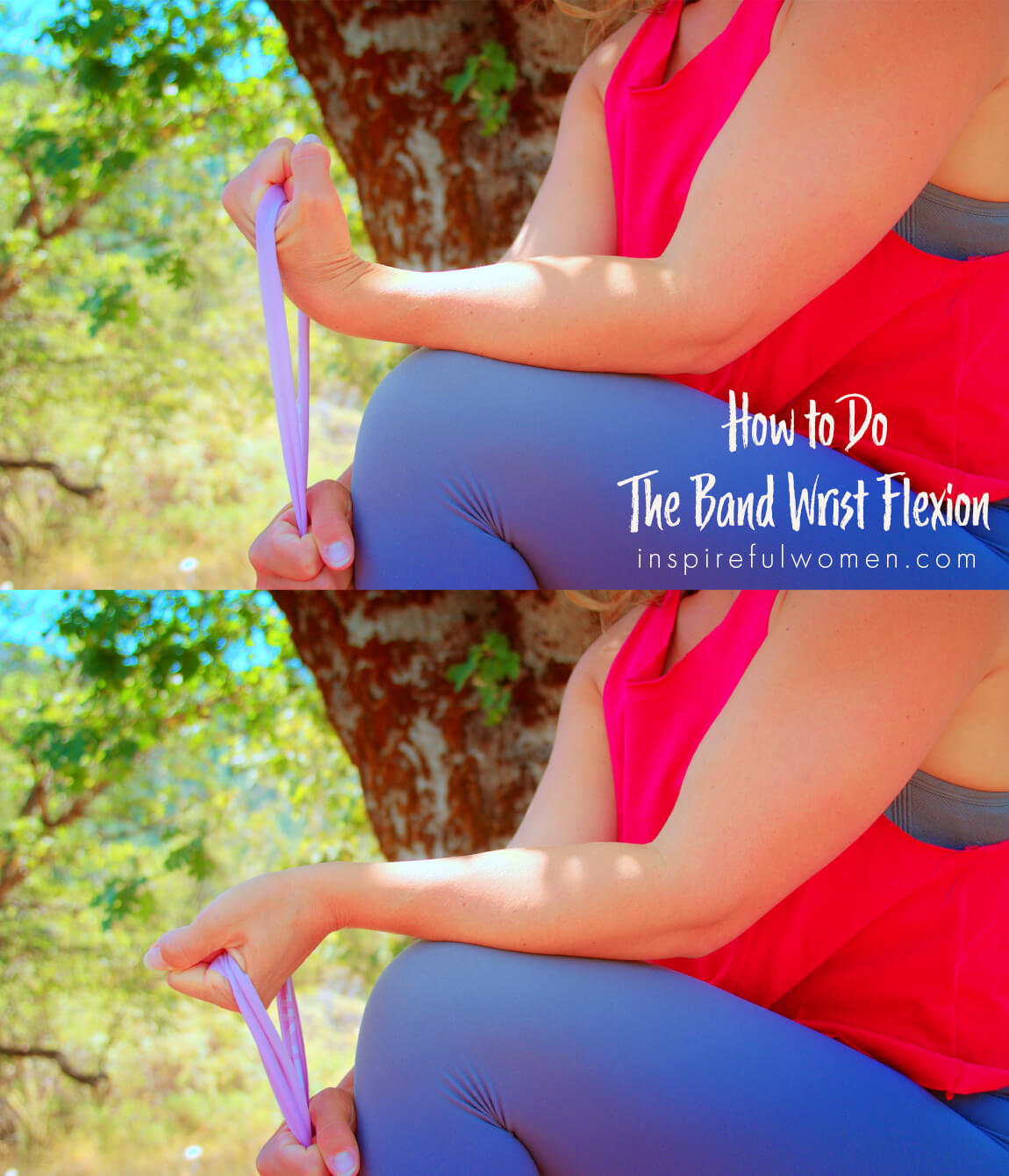
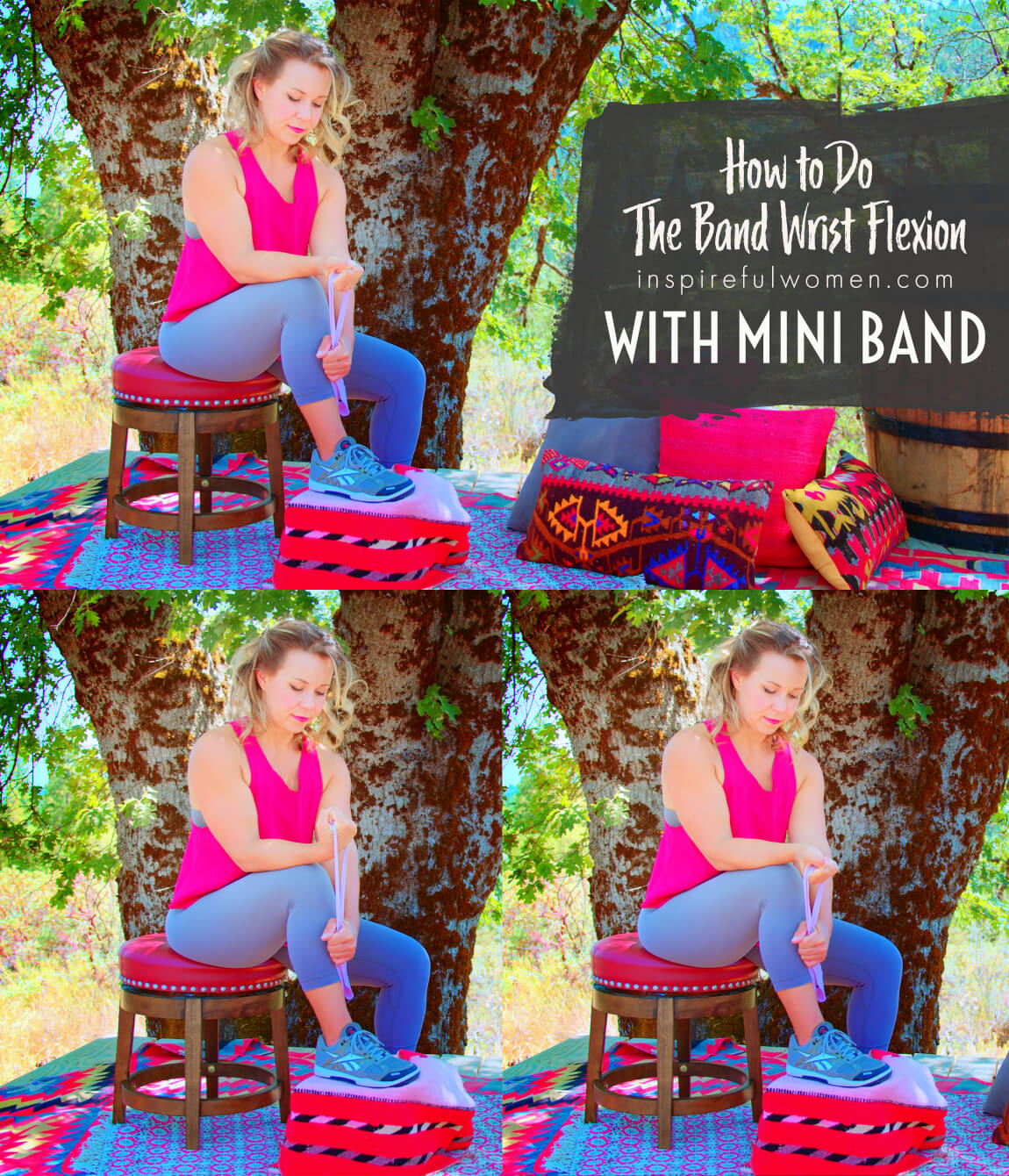
COMMON MISTAKES
COMMON MISTAKES
WHAT TO AVOID WITH THE Band Wrist Flexion
KEY TIP:
Guess what? Good news! Many avoids are the same for most movements. Once you learn the basics, there's really only a few extra avoids for each individual movement.
1. Avoid Bending elbows
AVOID: Avoid bending the elbow.
WHY NOT:
- This will result in using the biceps and triceps instead of the wrist flexors or extensors.
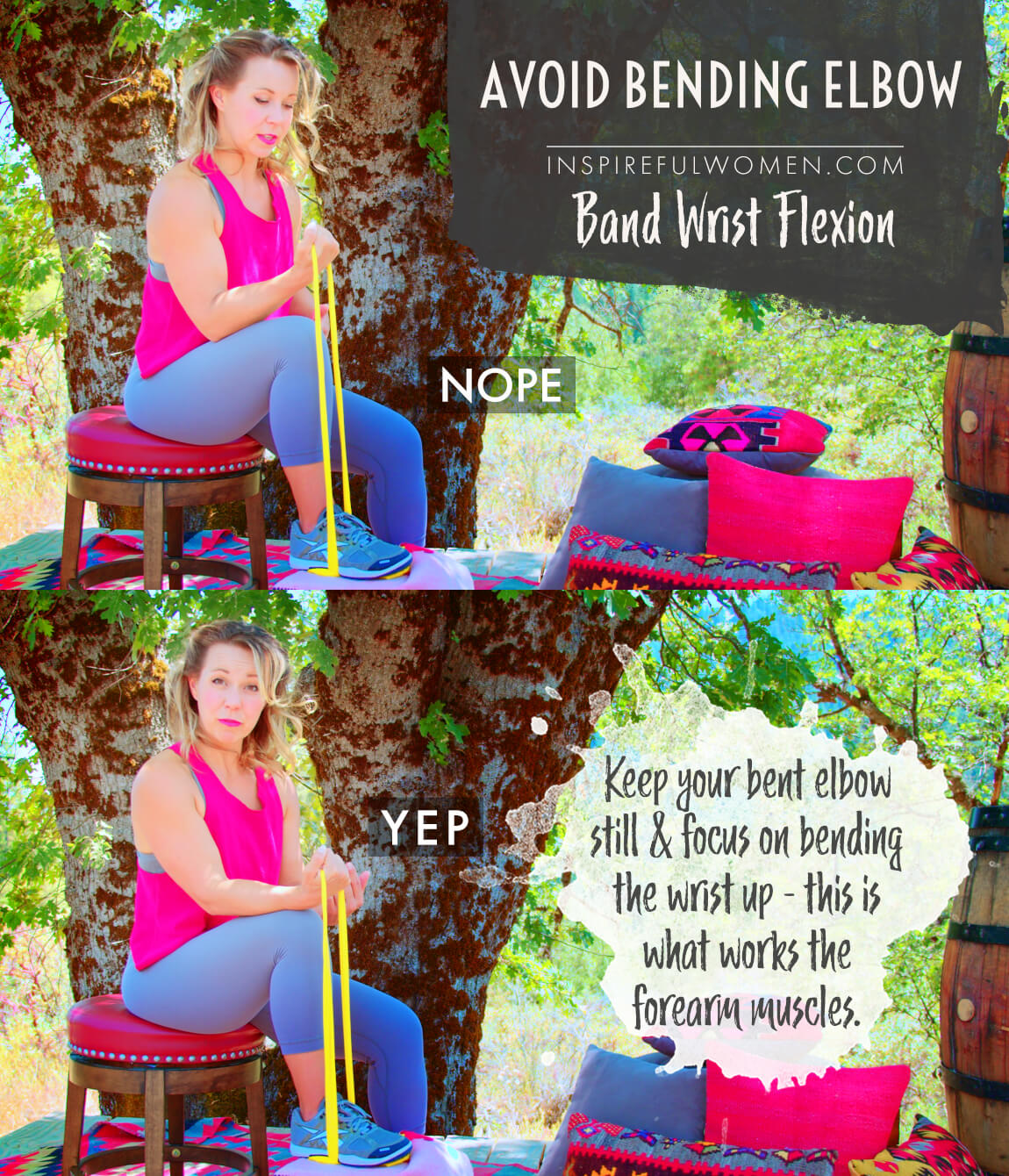
2. Avoid Bending wrist too much
AVOID: Avoid trying to push the movement as far as possible.
WHY NOT?
- There are 8 small bones that make up the wrist. The bones are attached to one another with many, many ligaments - trying to push the wrist into more flexion or extension may irritate these joints unnecessarily.
WHAT TO DO:
- Just move the wrist as far as it goes without any pushing - the movement should feel free and easy.
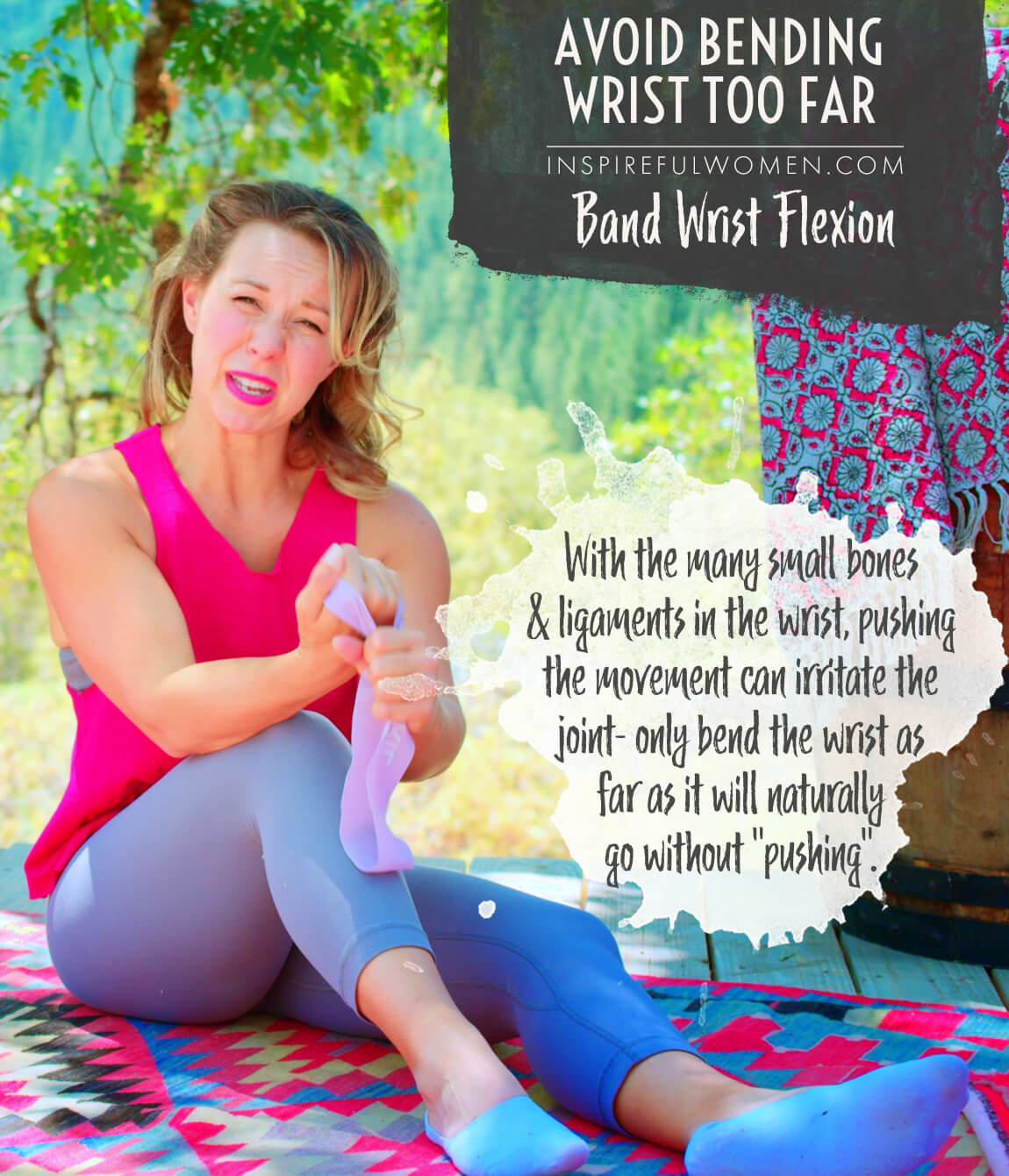
3. Avoid Too Much Resistance
AVOID: Avoid using too much weight.
WHY NOT?
- The muscles of the forearm are smaller muscles.
- Using too much resistance can irritate the tendons.
- The goal of the exercise is to wake the muscles up and improve the health of the muscle to prevent injury.
- If you are working the larger muscles of the upper arm, it is good to work the forearm so that you do not create a muscle imbalance that could lead to elbow or wrist pain.
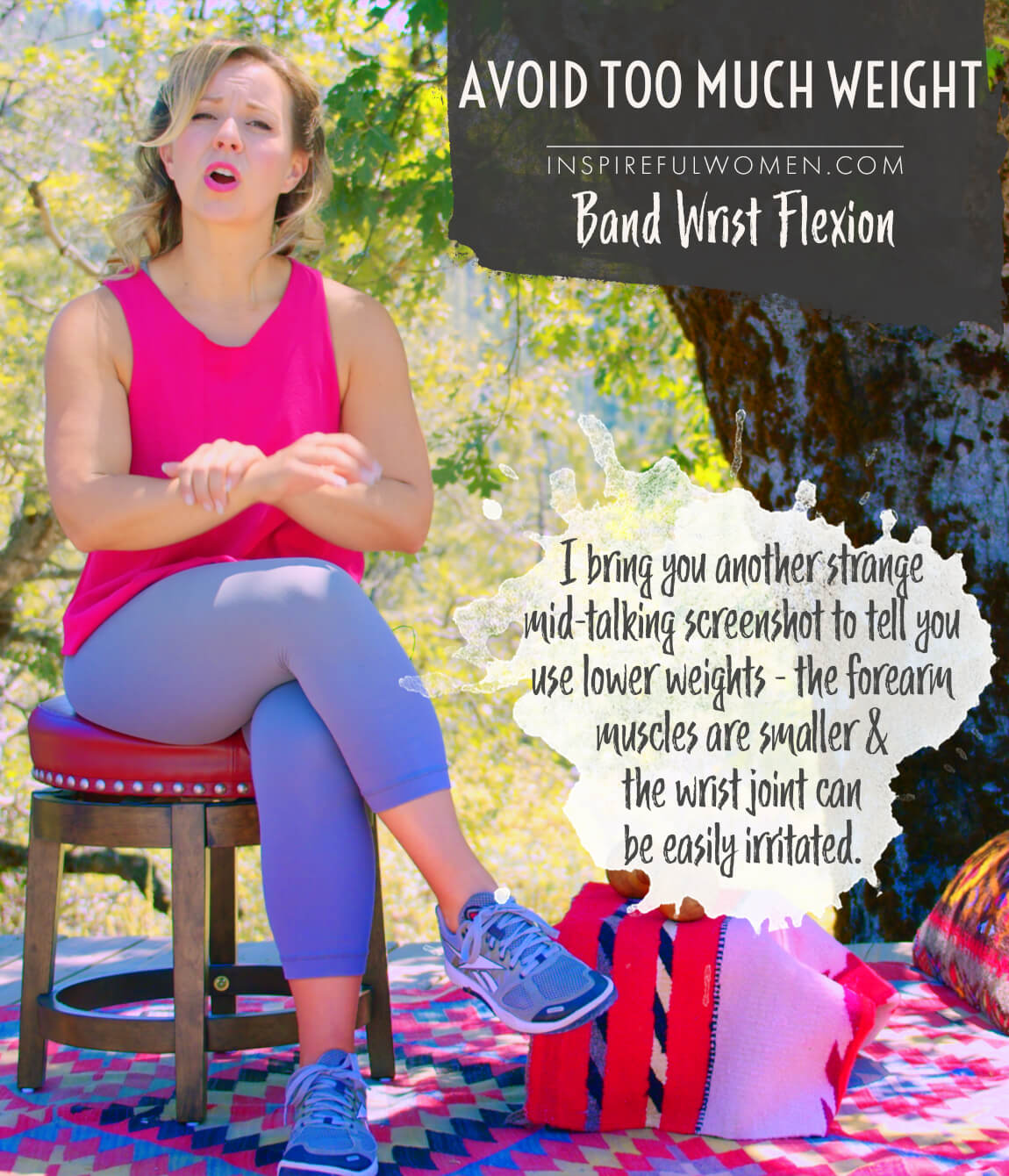
4. Avoid Too Many Reps
AVOID: Avoid doing too many reps when you are first adding these exercises.
WHY NOT?
- This is a general rule of thumb for all exercises but the tendons of the muscles that move the wrist seem to be easily irritated.
- There are many things that can contribute to this irritation: tight muscles, poor posture (the nerves that communicate with these muscles come from the cervical [neck] spine and can be irritated from poor posture), and repetitive use - this can be job or activity related.
WHAT TO DO:
- Start with one set of 6-8 reps and progress slowly.
- It helps to stretch the muscles after the rep.
- With the elbow straight, bend the wrist back until you feel a gentle stretch, hold for 30 seconds, repeat twice.
- With the elbow straight, bend the wrist forward until you feel a gentle stretch, hold for 30 seconds, repeat twice.
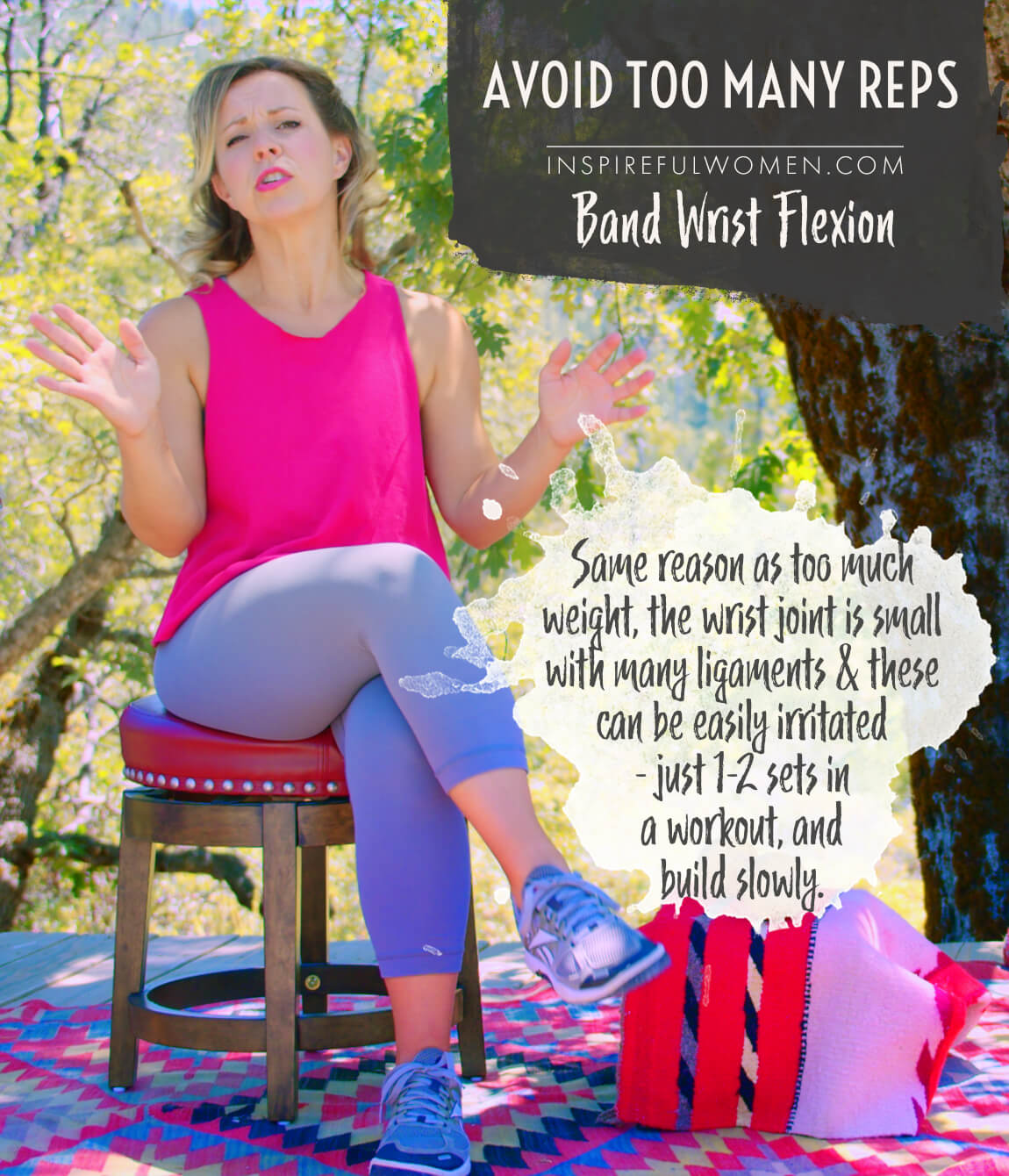
VARIATIONS
VARIATIONS
VARIATIONS OF Band Wrist Flexions
Add Finger Bending
Add Finger Bending
In the starting position - with the wrist bent back and the weight down, open the fingers slowly to let the weight roll down towards the fingertips. To begin the rep, bend the fingers to roll the weight up to the palm, then bend the wrist up as far as is comfortable. Slowly lower the hand back down and once again, allow the weight to roll out of the palm to the fingers. This variation adds finger flexion - the flexor digitorum superficialis and profundus will work to bend the fingers to pull the band up to the palm.

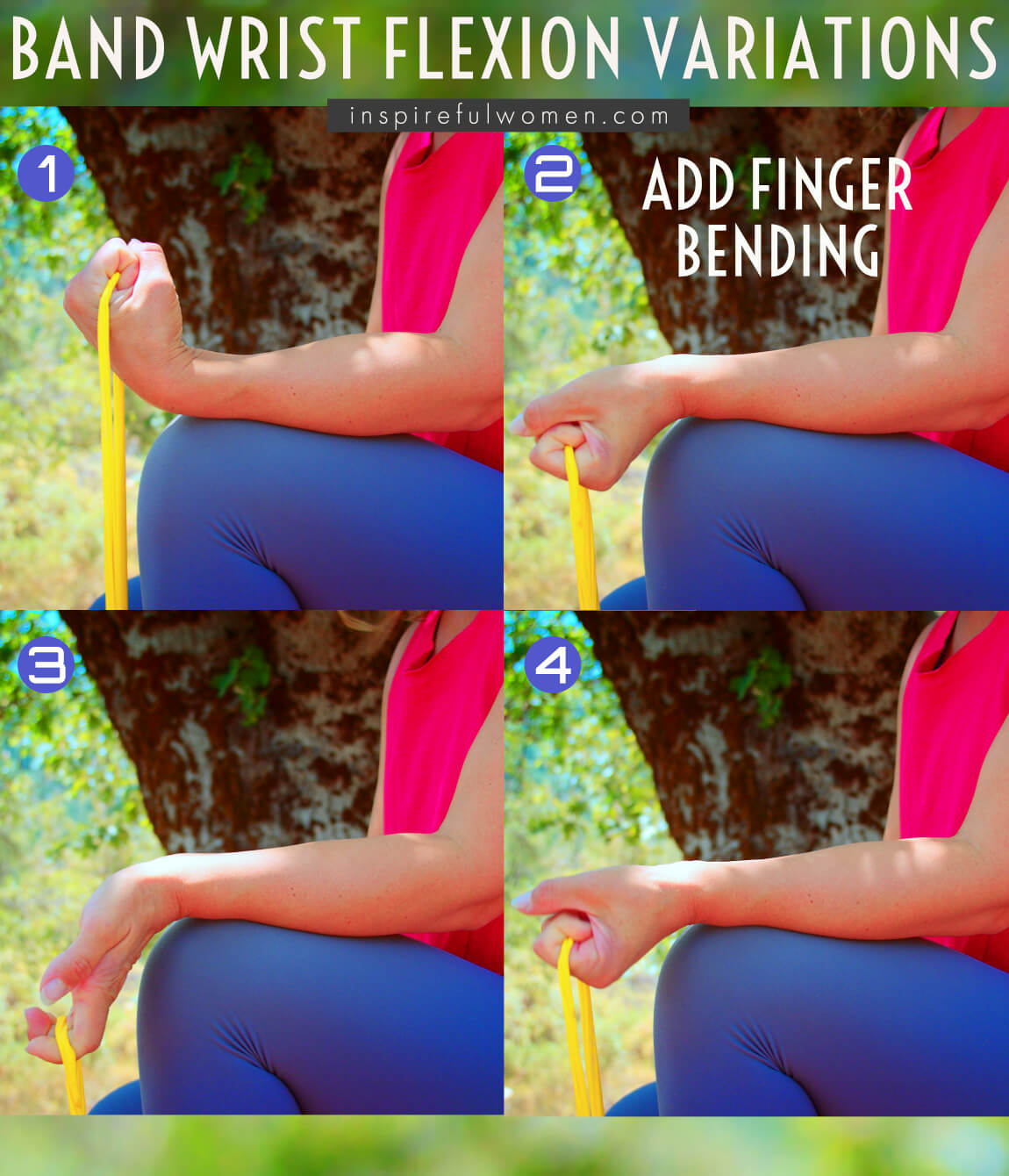
Standing
Standing Band Wrist Flexion

WHAT WE'RE DOING TODAY
WHAT & WHY
BENEFITS OF TRAINING THE Wrist MUSCLEs
WHAT
We move our wrists up and down with many daily activities. Bending the wrist to move the palm in towards the arm is called flexion and being the wrist to move the palm out, away from the arm is called extension. The exercises to target these muscles are straightforward. The forearm is held still while the wrist moves up or down. The muscles used for this are pretty small muscles, much smaller than the muscles of the upper arm. Because these are smaller muscles, lighter resistance is used for these exercises.
There are many upper body exercises that work the muscles of the wrist - nearly all upper body exercises, because you are holding a weight or a band with the wrist still in a neutral (not bent) position. These are great for strengthening the muscles of the wrist isometrically (no movement). Muscles are stronger isometrically than they are when they are moving a joint. The muscles will be weaker towards the ends of the range of movement. In order to keep the forearm muscles strong in any position, it is important to include exercises that involve moving the wrist through its range of motion.
WHY BOTHER DOING IT?
WHY
WHY DO WE EVEN CARE?
The primary job of the wrist is to move and stabilize the hand during all activities that involve using your hands. And, to take that a step further - the job of the shoulder and upper arm are to move the hand and hold it still so that you can use it. In order for the hand to perform the fine detailed movements that are needed to get through the day, like working on a computer, buttoning buttons, eating, driving, scratching, picking things up, holding items, washing, using a phone, pushing buttons, turning on lights, and flushing a toilet, the hand first has to be positioned correctly and held still.
COORDINATING OUTFITS, AHEM, MUSCLE STRENGTH
You know how when you put an outfit together, you coordinate it with the idea in mind that it all goes together well- a scarf compliments a top, and the top blends well with the shorts or what have you. And if you have, I don’t know, a hot pink top and a muddy orange scarf with some red pants and a royal blue belt, there’s something kind of….jarring about that mental picture isn’t there?
Well, muscles that are working at the same time as each other to do something is a similar idea. If these different muscles aren’t able to coordinate and work together well, it doesn’t just look bad like a bad outfit combo, but can cause injury and pain.
One cause of muscles not pairing well together is when one set of muscles is super strong and another set of muscles is really weak. This creates an imbalance - for example, the muscles can become overused or not healthy enough to do their job, then the area where the tendon attaches to the bone can become irritated - this is known as tendonitis (-itis means inflammation).
When you have strong shoulders and arms, they are capable of lifting heavyweights. But, if your forearm and hand muscles are not strong enough to support the weight, then you set yourself up for an injury. Strengthening the muscles that move and stabilize the wrist and hand will increase your ability to lift heavy things with less risk of injury. This is especially relevant for weight lifting. It is common to include exercises for the shoulders and upper arms, but much less common to include exercises to strengthen the forearm and hands.
LIFE OPENING JARS AS YOU KNOW IT IS ABOUT TO CHANGE - GRIP STRENGTH
With age, common daily tasks like opening jars, turning doorknobs and using can openers can become more difficult. Keeping the muscles of the forearm strong helps to prevent this from occurring.
Strengthening the muscles that move and stabilize the wrist and hand will improve your hand control for everyday tasks. Interestingly, grip strength is considered a pretty reliable predictor of overall health, strength, and cardiovascular disease, it has been used as an indicator of longevity and better grip strength has even been correlated with an improved likelihood of surviving cancer. Strengthening the muscles that cross the wrist can help to improve grip strength.
EVERYDAY LIFE
EVERYDAY LIFE &
MUSCLE FUNCTION
HOW WE USE OUR Wrist MUSCLES IN EVERYDAY LIFE
The main function of the forearm and wrist is to move and stabilize the hand during fine movements. The forearm muscles move the wrist to position the muscles that control the fingers in the best position (best length and line of pull) perform their job. This allows for very controlled fine movements of the fingers.
1. BENDING THE WRIST TO BRING THE PALM CLOSER TO THE FOREARM (FLEXION)
- Scooping sand towards you
- Dribbling a ball
- Pushing the toilet lever down
- Gesturing for someone to sit down
2. BENDING THE WRIST BACK OR DOWN (EXTENSION) - BACK OF HAND MOVING CLOSER TO THE FOREARM
- Pushing a door open
- Picking small items up off the table
- Holding you hand up to stop traffic
3. BOTH FLEXION AND EXTENSION OF THE WRIST
- Fanning yourself
- Waving
- Burping a baby
HOW TO FEEL WHAT MUSCLE IS WORKING
How to Feel What Muscle is Working
This is best done by resting your forearm on a table to minimize any contribution from the elbow flexors.
Extensors: The wrist extensors are primarily on the backside (or hairy side) of the forearm. They can easily be felt by setting the opposite hand on the backside of the forearm, a few inches below the elbow joint. Lift the fingers and hand back - the back of the hand moving towards the hairy side of the forearm (wrist extension). You should feel the muscle tighten under your fingers.
Flexors: Turn your forearm over so the underside or soft side is up. Place the fingers of the opposite hand a few inches below the elbow joint towards the inside of the forearm. Flex the wrist by pulling the palm of the hand up. You should be able to feel the muscles tighten.
SCIENCY STUFF
SCIENCY STUFF
SPIFFILICIOUS FACTS ABOUT MUSCLES & MOVES
Note: The names of the muscles of the forearm make it very easy to know what the muscle does.
Carpi refers to the wrist - the carpal bones are 8 small bones that form the wrist. Ulnaris means that the muscle lies on the side of the ulna so it can move the hand to the side of the ulna (ulnar deviation or adduction); and radialis means the muscle is on the side of the radius (radial deviation or abduction), so it can pull the hand to the side of the radius. The palmaris muscle attaches to the fascia on the palm of the hand.
The wrist flexors (flexor carpi radialis, flexor carpi ulnaris, palmaris longus) originate on the end of the humerus (upper arm bone) at the medial epicondyle (the bony part that sticks out just above the elbow joint) through a common tendon. The wrist flexors bend the wrist to move the palm of the hand closer to the underside of the forearm.
The wrist extensors (extensor carpi radialis longus and brevis, and extensor ulnaris) originate on the end of the humerus on the lateral epicondyle (bony part that is on the outside of the upper arm - just above the elbow) through the extensor tendon. An extension is pulling the hand back - the back of the hand moves towards the hairy side of the forearm.
ALLLL MUSCLES & WHEN
ALL MUSCLES WORKING & WHEN DURING THE Band Wrist Flexion
The muscles of the hand work a little bit just to hold the band - flexor digitorum profundus and superficialis, palmar interossei, and flexor digiti minimi brevis.
Flexor carpi radialis, flexor carpi ulnaris, and palmaris longus work concentrically to bend the wrist and move the hand up.
The same muscles work eccentrically as the hand returns to the starting position.
PIN IT FOR LATER!

